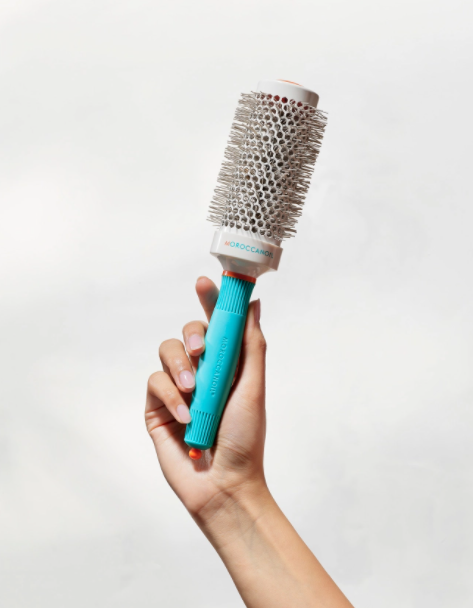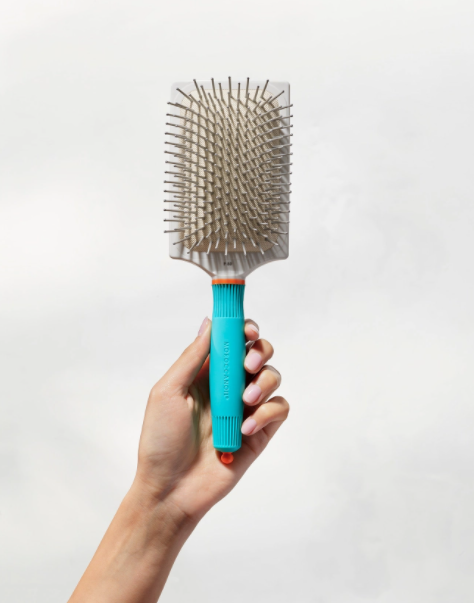If you’re anything like us, you probably consider the daily task of brushing your hair akin to tying your shoes or washing your hands—something you’ve done so many times you hardly give it any thought. But did you know that when it comes to daily brushing, there are best practices to keep in mind? Following the proper steps when brushing can help you avoid breakage, maintain soft shiny strands, and more. Read on for the scoop.
Benefits of Brushing Your Hair
Aside from the obvious—that is to say, detangling and generally making you look presentable—there are several benefits to gentle brushing. “It can
bring out shine in your hair by distributing natural natural oils throughout the hair,” says Moroccanoil Global Artistic Director
Kevin Hughes. It also
stimulates your scalp, which some research suggests may help
promote hair growth.
Last but not least, regular brushing can help expedite any shedding that naturally occurs. “It is completely normal to lose 50 to 100 strands of hair per day,” says Kevin. “
is a great way to remove those hairs.”
How Often to Brush Your Hair
Turns out that old “100 strokes a day” rule is a myth, according to both Kevin and the American Academy of Dermatology. (In fact, that amount of brushing is more likely to do harm than good.) The correct amount varies, but Kevin suggests brushing your hair only when styling it. “Overbrushing could cause more damage to your tresses.”
How to Brush to Detangle
When it comes to detangling, best practices differ somewhat depending on whether you’re dealing with wet hair or dry hair. One thing that remains consistent? Using the right tools. Kevin suggests that everyone invest in both a wide-tooth comb and paddle brush for detangling purposes.
Wet hair is particularly fragile, so it’s important to take a gentle approach. “You never want to rip or tear at the hair with rough brushing, this can cause damage and increase split ends,” says Kevin. Start by misting hair with a detangler like All in One Leave-in Conditioner, which also hydrates and helps protect hair from breaking. Then, using a wide-tooth comb, start gently working through tangles near the ends of your hair. Only once you’ve removed those tangles should you move to a higher section. Repeat until hair is completely tangle-free, then part as desired.
If you’re brushing to detangle or smooth dry hair—for instance, after waking up with a nasty case of bedhead—you should follow the same practice, starting at the bottom and working in sections. However, you can skip the comb and use a paddle brush instead. Just make sure you don’t use a round brush, as those are designed for use exclusively while blow-drying and can inflict damage if used for detangling purposes. Oh, and don’t forget to brush hair (while dry) before you wash it! The fewer tangles you end up with post-shampoo, the better.

Which Brushes are Best for Styling?
To minimize breakage and achieve smooth, shiny results when blow-drying, high-quality brushes are key. Our pick? Ceramic brushes.
“Ceramic brushes have several benefits, one of which is that ceramic heats up quickly and evenly,” says Kevin. “This is very important to make sure that all of your strands are being smoothed out by the heat and ceramic of the brush.” The even distribution of heat can also help speed up the hair drying process—and the less time your hair is exposed to heat, the better!
Additionally, ceramic is equipped with ionic properties that can help you achieve a better blowout. “Ceramic emits negative ions which help to seal that hair cuticle and reduce frizz,” according to Kevin. “You will also find that there is less static in the hair when using a ceramic hairbrush.”
A ceramic round brush is perfect for creating volume and body while blow-drying. Ours come in a variety of sizes to suit different hair types—choose smaller barrel sizes for short hair and larger barrel sizes for long hair. And if you have wavy or curly hair and want a straight, smooth blowout, start with a paddle brush—then, if needed, use a round brush at the end to add more volume to the finished look.
The bottom line? “The right brush can make your life so much easier, speed up your blow dry time as well as keep damage at bay, so be sure to invest in a good brush,” says Kevin. What’s not to love?



